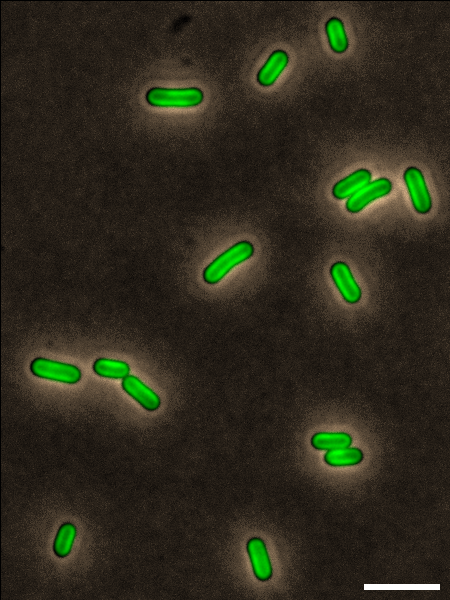Researchers Discover the Evolution of Seasonal Anticipation in Cyanobacteria
By Andy Flick, Evolutionary Studies scientific coordinator
Being able to correlate changes in day length with seasonal weather patterns is crucial for many organisms to adapt to their environments. Trees shed their leaves, arctic foxes grow thicker coats, and bears prepare for hibernation. But what about smaller, short-lived organisms? New research led by BBSRC Discovery Fellow at the John Innes Centre, in the UK and recent Ph.D. alumna Maria Luísa Jabbur from the Johnson Lab has uncovered that even cyanobacteria—tiny organisms with a generation time of just five to six hours—can sense and respond to changes in light availability, or photoperiod, to gear up for winter.

The new paper, “Bacteria can anticipate the seasons: Photoperiodism in cyanobacteria,” was published in the journal Science on September 6, 2024. According to the study, short (winter-like) days promote cold resistance in cyanobacteria.
Carl Johnson. Jabbur’s advisor and co-author on the paper, spoke to the novelty of the work.
“To me, the most exciting thing about these results are their ramifications for the evolution of biological timekeeping,” he said. “I think we ‘chronobiologists’ have always assumed that daily (circadian) clocks evolved before organisms could measure day/night-length and thereby anticipate the changing seasons. But the facts that (1) photoperiodism evolved in such ancient and simple organisms, and (2) our gene expression results implicate stress response pathways that probably evolved very early in life on Earth, suggest that photoperiodism might have evolved before circadian clocks. This is because either long days or long nights are differentially stressful for photoautotrophs like cyanobacteria, and therefore these conditions would be expected to trigger stress responses differentially. As a result of these selective pressures, photoperiodic time measurement might have evolved even before bona fide circadian clocks appeared. That possibility blows my mind!”
The role of clock proteins

The bacteria prepare for these winter conditions using clock proteins. The Johnson lab has a long history of studying circadian rhythms, especially in clock proteins known as KaiA, KaiB, and KaiC. These proteins exist in cyanobacteria and are responsible for the circadian rhythms of these short-lived organisms. To this end, the results above were undone when the clock proteins were turned off – changing the day length did not better prepare cyanobacteria for future cold conditions, suggesting cyanobacteria need their circadian clocks in order to be able to measure the length of the day and interpret it accordingly.
The team also found that the expression of the clock genes did not change between long exposure to daylight and short exposure to daylight. However, they did observe changes in the expression of genes that control lipid and fatty acid metabolism. Exposure to short-day or cold conditions led to the cyanobacteria to produce less dense (desaturated) fats and proteins. These desaturated molecules can help organisms adapt to and survive in cold temperatures.
One important aspect of this work is learning about the different phenotypes of cyanobacteria that exist in the wild. Specifically, the way in which cyanobacteria prepare for winter stresses is expected to vary by latitude. Jabbur referred to these differences as ‘latitudinal clines.’ She explained how cyanobacteria that are found in Nashville may begin preparing for winter earlier than cyanobacteria found in South Florida. This would be driven by unprepared cyanobacteria possibly not being able to survive in 10°C weather, which occurs in October in Nashville with about 12 hours of daylight and not until December in Florida with about 10.5 hours of daylight.
In the big picture

According to the paper, understanding the evolution of these bacteria to anticipate seasonality may help us better understand things like harmful cyanobacterial blooms and the effects of climate change. According to the study, blooms are often attributed to local conditions like temperature and nutrient availability; however, this may also be a seasonal, anticipatory response.
This anticipatory response, while often beneficial for the organism, can sometimes lead to unforeseen consequences. Research from the Johnson Lab has highlighted one such scenario, known as an ecological trap. This happens when organisms that evolve to have future success based on a current environmental cue may not be able to cope when the future environment changes but the current cue remains the same. In this case, Jabbur said it is known as a temporal mismatch where the number of hours of daylight do not change, but the climate conditions do change.
According to Jabbur, “the issue arises because photoperiod (day length) was previously a very reliable predictor of future conditions, but with climate change the relationship between the yearly photoperiod and temperature cycles is changing, and on top of that temperatures are becoming more unpredictable.”
This could spell trouble for these short-lived organisms that prepare for future weather conditions that never arise. However, Jabbur also noted that other teams have seen some adaptations to new climate conditions in other organisms, like birds, though the verdict remains out if these organisms will be able to adapt and evolve quick enough to keep up.
Citation: Jabbur, M.L., Bratton, B.P., Johnson, C.H. Bacteria can anticipate the seasons: Photoperiodism in cyanobacteria. Science. 385 (6713): 1105-1111.
Funding information: This study was supported by the National Institutes of Health (grants GM107434 and GM067152 to Johnson); Vanderbilt University’s College of Arts and Science Summer Research Award (to Jabbur); Vanderbilt University’s Russell G. Hamilton Graduate Leadership Institute Dissertation Enhancement Grant (to Jabbur); National Institutes of Health (grant P20GM103418 to the Lipidomics Research Center); National Science Foundation (grant DBI-1726527 to the Lipidomics Research Center); and US Department of Agriculture Hatch / Multi-State project 1013013 (to the Lipidomics Research Center).
